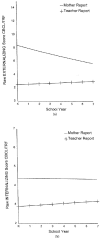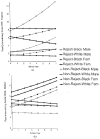A cross-domain growth analysis: externalizing and internalizing behaviors during 8 years of childhood
- PMID: 10834768
- PMCID: PMC2775438
- DOI: 10.1023/a:1005122814723
A cross-domain growth analysis: externalizing and internalizing behaviors during 8 years of childhood
Abstract
In a sample of 405 children assessed in kindergarten through the seventh grade, we determined the basic developmental trajectories of mother-reported and teacher-reported externalizing and internalizing behaviors using cross-domain latent growth modeling techniques. We also investigated the effects of race, socioeconomic level, gender, and sociometric peer-rejection status in kindergarten on these trajectories. The results indicated that, on average, the development of these behaviors was different depending upon the source of the data. We found evidence of the codevelopment of externalizing and internalizing behaviors within and across reporters. In addition, we found that African-American children had lower levels of externalizing behavior in kindergarten as reported by mothers than did European-American children but they had greater increases in these behaviors when reported by teachers. Children from homes with lower SES levels had higher initial levels of externalizing behaviors and teacher-reported internalizing behaviors. Males showed greater increases in teacher-reported externalizing behavior over time than did the females. Rejected children had trajectories of mother-reported externalizing and internalizing behavior that began at higher levels and either remained stable or increased more rapidly than did the trajectories for non-rejected children which decreased over time.
Figures




References
-
- Achenbach TM. Manual for the Child Behavior Checklist/4-18 and 1991 Profile. Burlington, VT: University of Vermont Department of Psychiatry; 1991a.
-
- Achenbach TM. Manual for the Teacher's Report Form and 1991 Profile. Burlington, VT: University of Vermont Department of Psychiatry; 1991b.
-
- Achenbach TM, McConaughy SH, Howell CT. Child/adolescent behavioral and emotional problems: Implications of cross-informant correlations for situational specificity. Psychological Bulletin. 1987;101:213–232. - PubMed
-
- Angold A. Childhood and adolescent depression: I. Epidemiological and aetiological aspects. British Journal of Psychiatry. 1988;152:601–617. - PubMed
Publication types
MeSH terms
Grants and funding
LinkOut - more resources
Full Text Sources
Medical
